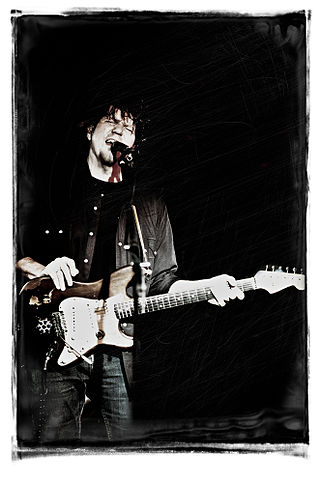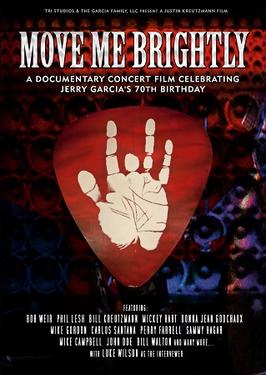
The Grateful Dead was an American rock band formed in Palo Alto, California in 1965, known for their eclectic style that fused elements of rock, blues, jazz, folk, country, bluegrass, rock and roll, gospel, reggae, and world music with psychedelia. The band is famous for improvisation during their live performances, and attracted a devoted fan base, known as "Deadheads". According to the musician and writer Lenny Kaye, the music of the Grateful Dead "touches on ground that most other groups don't even know exists." For the range of their influences and the structure of their live performances, the Grateful Dead are considered "the pioneering godfathers of the jam band world".

Phil Lesh and Friends is an American rock band formed and led by Phil Lesh, former bassist of the Grateful Dead.

Robert Hall Weir is an American musician and songwriter best known as a founding member of the Grateful Dead. After the group disbanded in 1995, Weir performed with The Other Ones, later known as The Dead, together with other former members of the Grateful Dead. Weir also founded and played in several other bands during and after his career with the Grateful Dead, including Kingfish, the Bob Weir Band, Bobby and the Midnites, Scaring the Children, RatDog, and Furthur, which he co-led with former Grateful Dead bassist Phil Lesh. In 2015, Weir, along with former Grateful Dead members Mickey Hart and Bill Kreutzmann, joined with Grammy-winning singer/guitarist John Mayer, bassist Oteil Burbridge, and keyboardist Jeff Chimenti to form the band Dead & Company.
Tom Constanten is an American keyboardist, best known for playing with the Grateful Dead from 1968 to 1970, for which he was inducted into the Rock and Roll Hall of Fame in 1994.

Dark Star Orchestra is a Grateful Dead cover band formed in Chicago, Illinois. They serve now as an international touring tribute band to the rock group the Grateful Dead. Since 1997, the band has been "celebrating the Grateful Dead concert experience."

Joe Russo is an American drummer and half of the Benevento/Russo Duo. He has toured, performed and recorded with a number of other bands, including Cass McCombs, A Big Yes and a Small No, Fat Mama, Robert Walter's 20th Congress, Bustle In Your Hedgerow, Younger Brother, Shpongle, Tom Hamilton's American Babies, the Trey Anastasio/ Mike Gordon duo, the Gene Ween Band, and Furthur. He also plays with the Shpongle Live Band. In 2013 he formed a Grateful Dead tribute band called Joe Russo's Almost Dead.

Jeff Chimenti is an American keyboardist, best known for his ongoing work with former members of the Grateful Dead. Since May 1997 he has played with Bob Weir & RatDog, and has also played on every tour of The Dead and Furthur. He currently plays with Dead & Company.

Terrapin Station (Limited Edition) is a triple CD live album by the Grateful Dead released in 1997. It was recorded on March 15, 1990—bassist Phil Lesh's 50th birthday—at the Capital Centre in Landover, Maryland, and contained a rare Beatles cover, "Revolution". "Revolution" was a favorite song of Lesh's and had previously been played at his request. It also features the first performance of "Easy to Love You" in almost 10 years. The concert performance from the previous night, recorded at the same venue, can be found on Spring 1990 (The Other One). Likewise, the concert from the following night, at the same venue, is contained on Spring 1990. Additionally, the performances of "Walkin' Blues" and "Althea" from this show can be found on the live compilation album Without a Net. Proceeds from this release were originally planned to support the construction of a multi-media Grateful Dead museum and concert venue; however, the plans fell through and were eventually replaced with Lesh's Terrapin Crossroads restaurant and concert venue.

The Dead was an American rock band composed of some of the former members of the Grateful Dead along with other musicians that were involved in some capacity with the "Dead Ethos". Throughout "The Dead's" career they had a revolving list of members leaving and joining the band including the former members of the Grateful Dead.

Mark Karan is an American guitarist and singer. He is best known for his long-term work with former members of the Grateful Dead, in RatDog (1998–2013), the Other Ones (1998–2000), Mickey Hart's band Planet Drum (1999), and Phil Lesh and Friends (2012). Karan has also played and toured with Terrapin Flyer, Delaney Bramlett, the Rembrandts, Sophie B. Hawkins, Dave Mason, and Paul Carrack.

The Grateful Dead were an American rock band known for their lengthy, partially improvised performances, as well as for a loyal fan base who often followed the band for several shows or entire tours. They disbanded in 1995, following the death of de facto bandleader Jerry Garcia. Since then remaining members have reunited for a number of concert tours and one-off performances, often in very different configurations. The following is a list of instances where former Grateful Dead members have reunited.

Furthur was an American rock band founded in 2009 by former Grateful Dead members Bob Weir and Phil Lesh. The original lineup also included John Kadlecik of Dark Star Orchestra on lead guitar, RatDog's Jeff Chimenti on keyboards and Jay Lane on percussion, and Joe Russo of the Benevento/Russo Duo on drums. Named after the famous touring bus used by Ken Kesey and the Merry Pranksters in the 1960s, Furthur was an improvisational jam band that performed music primarily from the extensive Grateful Dead songbook, as well as their own original music and that of several other well-known artists. In addition to the original members, the band's lineup included backup vocalists Sunshine Becker of the a cappella ensemble SoVoSó and Jeff Pehrson of the folk rock bands Box Set and the Fall Risk. After five years, Furthur disbanded in late 2014.

John Kadlecik is an American guitarist. He was a founding member as the lead guitarist for the Grateful Dead tribute band, Dark Star Orchestra, in 1997. From 2009 to 2014 he performed with original Dead members Bob Weir and Phil Lesh in Furthur.
Tom Hamilton Jr. is an American songwriter, musician, and producer best known as the lead vocalist and guitarist for the bands Brothers Past, American Babies, Joe Russo's Almost Dead, Bill Kreutzmann's Billy & the Kids, and Electron.

Sunshine Becker is an American singer who performed backing vocals for the band Furthur. Despite her maiden name, Garcia, she is not related to Jerry Garcia, an incorrect assumption made by some because of her involvement with Furthur, a post-Garcia incarnation of the Grateful Dead. Similarly, despite her first name, Sunshine, she is not to be confused with Sunshine Kesey, daughter of Ken Kesey and Carolyn Adams, Jerry Garcia's second wife.

Terrapin Crossroads was a music venue, bar, and restaurant active from 2011 until 2021 in San Rafael, California, founded by former Grateful Dead bassist Phil Lesh.
Lockn' Festival, first known as Interlocken Music Festival, was an annual four-day music festival held at Oak Ridge Farm near Arrington in Nelson County, Virginia. The festival focused primarily on jam bands and other music improvisation acts. Its inaugural event took place September 5–8, 2013, drew nearly 25,000 fans and featured notable groups such as Furthur, Trey Anastasio Band, Gov't Mule, Widespread Panic featuring John Fogerty, The String Cheese Incident featuring Zac Brown, and The Black Crowes.

Move Me Brightly is a music documentary film. It contains live performances of Grateful Dead songs from a 2012 concert by Bob Weir and a number of other musicians, called "Move Me Brightly: Celebrating Jerry Garcia's 70th Birthday". The film also includes interviews with some of the performers, other musicians, and members of the Grateful Dead extended family. It was released on DVD and Blu-ray in 2013.

Scott Guberman is an American keyboardist best known for his work with founding Grateful Dead bassist, Phil Lesh. After relocating to the Bay Area from the East Coast In 2015, Guberman was asked to join Phil Lesh's band "Communion". He now plays regularly as a member of Phil Lesh & Friends and with Lesh in other formations at Terrapin Crossroads.

Fillmore West 1969: February 27th is a live album by the rock band the Grateful Dead. As the name suggests, it was recorded on February 27, 1969, at the Fillmore West in San Francisco. It was produced as a four-disc vinyl LP, in a limited edition of 9,000 copies. It was released on April 21, 2018, in conjunction with Record Store Day.



















